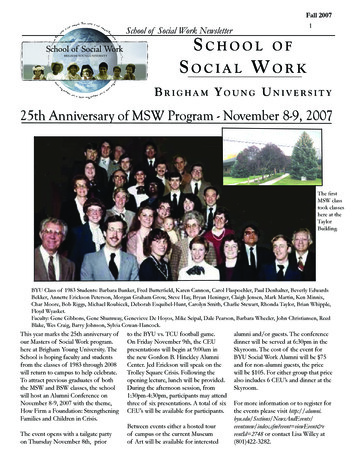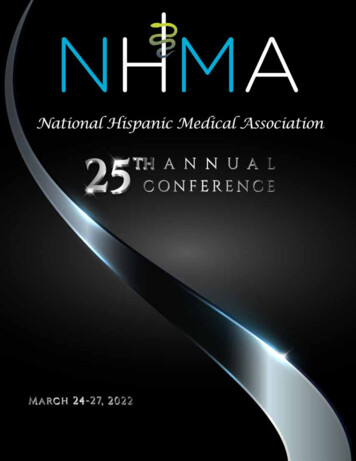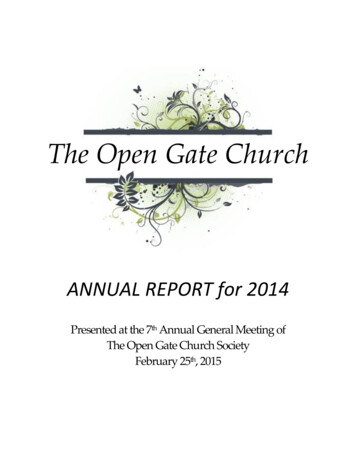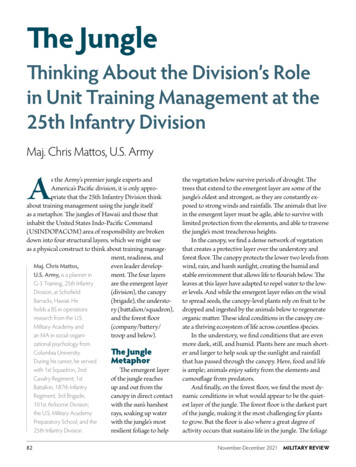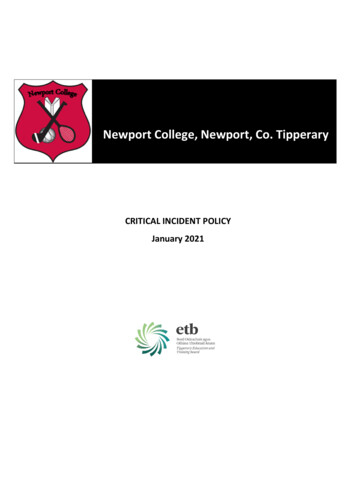
Transcription
- WEHRHEIM SCHOOL OF NURSING -y25th AnnualScholarshipSymposiumFRIDAY, APRIL 29TH, 2022- MILLERSVILLE UNIVERSITY -
25th Annual Scholarship SymposiumTABLE OFFrom our Chair .3Agenda .4Presentations .7Doctor of Nursing Practice Students . 17Masters of Science in Nursing Students . 33Faculty . 69Ms. Liselotte R. Wehrheim . 70Evaluation . 71Thank You to our Sponsors! . 72Find us at . 742
FROM OUR CHAIR:Welcome the 25th Annual Scholarship Symposium. As I reflect on the previous 20 symposiumsI've attended at Millersville University, I amamazed by the growth I've witnessed. Not onlyhas the program grown in size, but the levels ofscholarship and innovation have flourished. Oneof the most satisfying aspects of being a facultymember is seeing our students mature in theirprofessional roles and witnessing their hard workcome to fruition in the works you will see today.3This symposium is particularly special as we followour celebration of scholarship with a celebrationof the naming of the Wehrheim School of Nursing. We are thrilled youhave chosen to celebrate with us.Kelly A. Kuhns, PhD, RN, CNEChair and ProfessorDNP Program DirectorDepartment of Nursing3
25th Annual Scholarship SymposiumMORNING08:00Welcome08:15DNP Cohort IV10:15Break!10:30MSN PodiumsReceive 2.75 Contact Hours for attending this session4
25th Annual Scholarship SymposiumMID-DAY11:00Lunch & MSN Posters(feel free to enjoy lunch as your socialize and review theposter presentations)11:30Poster Group A12:00Poster Group BReceive 1.0 Contact Hours for attending this session5
25th Annual Scholarship SymposiumAFTERNOON12:30Breakout Sessions:MSN Podiums in MPRDNP Cohort V in Room 118E13:45Break14:00Breakouts Resume15:00Closing and Awards15:30Reception and Dedication of theWehrheim School of NursingReceive 2.5 Contact Hours for attending this session6
DNP COHORT IVInterdisciplinary Collaboration in Addressing theNeeds of Students Diagnosed withPediatric Autoimmune Neuropsychiatric DisordersAssociated with Streptococcal InfectionsTiffany BoydMotivational Interviewing to Increase Adherence ofTherapies for Improved Management and OutcomesAmong Patients with Type 2 Diabetes MellitusShelly CorleIntegrating Evidence Based Screening, Brief Intervention, and7 into a FNP ProgramReferral to Treatment (SBIRT)ChangeKelly FetterhoffUtilizing Prenatal Education and the Edinburgh PostnatalDepression Scale to Improve the Detection of DepressionAmong Healthcare Providers and Men in thePostpartum PeriodTaasha GuillemetteImplementation of an Educational Program andSchool Nurse Procedure to Address Adolescent VapingAlicia ShelkinDietary Self-Monitoring for Weight Loss in Adults with ObesityHeather Shuker7
MORNING MSN PODIUMSGreening Education: An Eco-Centric EducationProgram to Promote Sustainable Values AmongHealthcare PersonnelMeredith JesterThe Importance of Gender-Affirming Practices in PrimaryCareJessie StefanescuThe Effect of Mobile8Health Technology onChronic Disease Management and Recommendationsfor the Nurse PractitionerBethany Han8
MSN POSTER GROUP AAdvance Care Planning: The Need to ImplementSusan BaldwinProvider-Patient Relationships and Medication Adherence:An Evidence-Based AnalysisAugustine CherbarwettAn Interdisciplinary Approach toFall Management in Clinical SettingsNavdeep GhumanEffectiveness of the Buzzy Device During9Needle Related Proceduresin ChildrenCaleb GishFamily Nurse Practitioner:Primary Care of the Cardiac PatientCassandra HelwigHealth Coaching in Type 2 Diabetes:An Evidence-Based Practice AnalysisBrad Hertzler9
MSN POSTER GROUP AParental Vaccine Hesitancy: Overcoming BarriersKelsey KimenhourThe Effect of Hand Hygiene on EliminatingC. Diff From Caregivers' HandsBeth LinnenbaughBarriers and Facilitators to Mental Health Collaboration inthe Primary Care Setting: A Literature SynthesisBeth ProginStriving for Retention of Provider Empathy: The Impact of the10COVID-19 Pandemic on Provider BurnoutMelissa ShroyMorphine Equivalent Dosing:A Helpful Tool to Keep Patients SafeMeghan CrookSlowing the Rate of Cognitive Impairment: Nutritional VersusPharmaceutical InterventionsRebekah Troutman10
MSN POSTER GROUP BProviders’ Roles in Addressing Vaccine HesitancyAndrey BozhkoSerologic Testing for Diagnosis of Acute Lyme DiseaseCourtney GreinerUtilizing the Teach Back Method in Heart Failure EducationErica LehmanWeight Bias in Healthcare and its Impact onPatient Outcomes:How Provider’s Internal11 Bias Can Lead toPoor Quality of Care and Poor Patient OutcomesLeigh McKissickThe Effect of Medical Cannabis Laws onOpiate Related DeathsDanielle MillerFirst Responder Mental Health Screening andSuicide Prevention Recommendationsfor the Family Nurse PractitionerRachel Mowry11
MSN POSTER GROUP BProviding Medical Care to the Unsheltered Through StreetMedicine: A Case StudyAntonio NeveFamily Practice Provider's Influence Upon HealthcareAccess for the LGBTQ Population:Practice RecommendationsNatalie PrestonWhole Foods Plant Based Diet12 to Decrease Hypercholesterolemia in Adults without Medication: Nurse PractitionerEducation RecommendationsJeannette StambaughAcupuncture as an Adjunct to SSRIs forSymptom Management in Major Depressive Disorder:A Literature SynthesisAmy VedderBarriers to Implementing Physician Assisted Suicide as anIntervention for Patients Who Are Terminally IllLeah Dawson12
AFTERNOON MSN PODIUMSOvercoming Mental Health Disparities in the African American Community: Interventions for the Nurse PractitionerTiara BrownPalliative Care for the Nurse Practitioner:Bridging the Gap in Education andIdentifying the Purpose of Our RoleMichelle StojanovicEvaluating the Use of an Escape Room toReinforce APA StyleJustin13McFailAntibiotics:A New Standard for the Treatment ofUncomplicated Acute AppendicitisJesse ThomazNon-pharmacological Modalities toImprove Sleep-Related OutcomesJennifer Weaver13
AFTERNOON MSN PODIUMSHow Family Nurse Practitioners Can ImproveExercise Adherence in Patients with Heart Disease:A Literature ReviewAlex ToppinDevelopment and Implementation of a Postpartum AnxietyTeaching Plan for Baccalaureate Nursing StudentsNicole GrissingerNursing Students’ Perspectives on the Most ValuedCharacteristics of Nursing Clinical Instructors:14 ReviewAn IntegrativeAndrew GlindemanEffective Screening Tools for Depression and Anxiety in Adolescents in the Primary Care Setting: A Literature SynthesisBradly Wevodau14
DNP COHORT VKnowledge Retention Post StrokeNaomi AcheampongImpact of Improved Parental Coping and Success withPediatric Constipation TreatmentLisa IngallsAdverse Childhood Trauma (ACES), Secondary Trauma,and Suicide PreventionDiane Klescewski15Integrating Psychosocial Interventions inOffice-Based Opioid Treatment ProgramsJames NdunguImplementing Screening for Child Sex Trafficking inthe Emergency DepartmentJocelyn Ramirez Harrell15
DNP COHORT VCombatting Heart Disease in the Fire ServiceEmily SerikstadBurnout Among Acute Care NursesKathryn TreasterPrevention of Substance Use Disorder Among HealthCare WorkersJulia WauchopetoImproving Interdisciplinary Collaborationand Communica16tion in Caring for Patients with Extracorporeal MembraneOxygenation (ECMO)Kelly Williams16
DOCTOR OFNURSING PRACTICECOHORT IVPROJECTS
25th Annual Scholarship SymposiumInterdisciplinary Collaboration in Addressing theNeeds of Students Diagnosed with Pediatric AutoimmuneNeuropsychiatric Disorders Associated withStreptococcal InfectionsPediatric Autoimmune Neuropsychiatric Disorders Associatedwith Streptococcal Infections (PANDAS) is an autoimmunedisorder associated with a sudden onset of OCD and/or ticsand frequently diagnosed between the ages of 3 andpuberty. This sudden onset of OCD and/or tics can lead tounwanted behaviors in school. Interdisciplinary collaborationbetween the school nurse, school counselors, psychologists, andprincipals are important to increasing referrals to the school nursewhich can assist in further identification of the behaviors, referralto outside healthcare providers, and contributes to improvedschool outcomes. The primary purpose of this project was toprovide education on PANDAS leading to an increase in referralsof students to the school nurse.A self-directed onlineeducational intervention was employed for all district-wide schoolnurses, counselors, principals, and psychologists. A pretestposttest design was utilized to assess knowledge related toPANDAS before, immediately after, and six-weeks after theeducational intervention. A referral log was also implemented totrack the number of referrals to the school nurse from schoolcounselors, principals, and psychologists for behaviors consistentwith PANDAS. Final sample size included 19 participants. Apaired t test showed a statisticallysignificant gain in pretest toposttest scores suggesting theeducationinterventionwaseffective. In addition, initiation ofa referral process led to anincrease in school nurse referrals,supporting the value of fany M. BoydMSN, BS, RN, CSN18
25th Annual Scholarship SymposiumMotivational Interviewing to Increase Adherence ofTherapies for Improved Management and OutcomesAmong Patients with Type 2 Diabetes MellitusBackground: Type 2 diabetes mellitus (T2DM) is a complicated disease process that impacts millionsof Americans yearly. Type 2 diabetes mellitus can cause severe, even fatal complications, includingrenal disease and failure, cardiac complications, neuropathy, and retinopathy. These complicationsreduce the quality of life and ultimately can result in death. Type 2 diabetes mellitus requires patientself-management to maintain glycemic control through diet, glucose monitoring, and medicationregimesMethod: A multimodal education program using the Diabetes Assessment form, educationalmaterials, and motivational interviewing was provided to patients with a hemoglobin A1c greater than7.0 by team members. The healthcare members were a healthcare providers (MD/CRNP’s), licensedpractical nurse, and medical secretary. Diabetes Assessment Form and hemoglobin A1c wascompleted pre-intervention and post-intervention.Motivational interview conversations werecompleted via telemed two and four weeks after consent was obtained. Eight of nine patientscompleted the project.Results: Initial hemoglobin A1c ranged between 7.4 and 13.2. (SD 2.702). Overall, there wasno statistically significant difference in hemoglobin A1c following the MI interventions. However, fivepatients (55%) did show a decrease of the hemoglobin A1c. Four of the eight patients demonstrated aclinically significant decrease in hemoglobin A1c (decrease of greater than 0.5%). Further, of thosepatients whose hemoglobin A1c, none increased by greater than 0.3%. Medication adherence hasbeen found to be a consistent challenge for patients with diabetes. Data collected on the DAF preintervention demonstrated that 55% (n 4) were taking their mediations daily as instructed, 33 %(n 3) were medicating most of the time and one patient took their medication sometimes.Sustainability: Utilizing the DAF could be a cost effective, quality-based care initiative that will continueto optimize health as evidenced by outcomes and patient experience. Motivational interview is avaluable tool that could allow for improved communication between providers, nursing, andpatients. Conversations between all parties can influence efficient, cost-effective changes inchallenging situations, Further, quality care measures will continually be connected to pay out fromCMS and utilizing the DAF will continue to support the quality initiatives suggested by CMS.Conclusion: Motivational interviewing can be utilized by various health professionals and can bedelivered within a short time. Improvement of healthmanagement in short-term intervals is a feasiblegoal; however, short-term variables are unreliable.Long-term implementation commitment would be akey element to success within the qualityimprovement study. Motivational interviewing canalso decrease the cost of care long-term for theinsurance companies and patients by reducinghospital stays, diminishing the need for multiplemedications, and lost wages due to multipleappointments necessary to manage the disease.Education with MI in chronic disease managementcan forward healthcare into a positive interventionfor all involved in the healthcare system.Michelle Lee CorleMSN, CRNP19
25th Annual Scholarship SymposiumIntegrating Evidence Based Screening, BriefIntervention, and Referral to Treatment (SBIRT) into aFNP ProgramScreening, Brief Intervention and Referral to Treatment (SBIRT) is acare model used to identify substance misuse, reduce use, and assistpatients in getting the proper treatment. SBIRT has been extensivelyresearched and shown to reduce dangerous use of alcohol anddrugs, as well as creates a bridge between the general medical setting and specialized treatment centers. SBIRT began in the primarycare setting and has been used to screen patients for risky substanceuse, provide a BI and refer patients to the ap- propriate treatment.Any point of contact with a healthcare professional trained in SBIRTcould be used as an opportunity to get a patient into treatment. Myevidence-based practice (EBP) project integrated SBIRT into the curriculum of a graduate level Family Nurse Practitioner (FNP) programin south-eastern PA via the D2L/Bright space online environment, toincrease the students’ knowledge of Substance Use Disorders (SUD)and their treatment and increase their motivation to work with patients with SUD. A pre-and post-test design was used to compare themean (paired t-test) scores of the Shortened Version of Alcohol andAlcohol Problems Perception Questionnaire (the SAAPPQ), Drug andDrug Problems Perception Questionnaire (DDPPQ) and a tenquestion knowledge test before and after the students completed theonline education (n 67). All results were statistically significant. Theeducation improved role adequacy, task self-esteem, motivation, rolelegitimacy, and satisfaction of FNPswhen working with patients whoabuse alcohol. Role adequacy, rolelegitimacy, role support, task specific self-esteem and job satisfactionwere also increased in FNPs whenworking with patients who abusedrugs. There was also a statisticallysignificant increase in knowledgefollowing the education.Kelly Anna FetterhoffMSN, CRNP, PHMNP-BC, CARN-AP20
25th Annual Scholarship SymposiumUtilizing Prenatal Education and the EdinburghPostnatal Depression Scale to Improve the Detectionof Depression Among Men in the Postpartum PeriodBackground: Transitioning into the role of the parent can be very stressful for both motherand father. In the past, maternal postpartum depression (MPPD) has received a lot of attention. Paternal postpartum depression (PPPD), in contrast, has been underreported, underrecognized, underdiagnosed, and undertreated and it is essential to acknowledge the potential risk for this depression. Because of the effect postpartum depression, whether it be maternal or paternal, can have on the father, mother, child, and family, healthcare providers needto assess both the mother and the father for postpartum depression.Purpose: The utilization of a prenatal multimodal educational initiative concerning PPPDpresented an opportunity to introduce the importance of assessment, detection, recognition,and treatment of this depression to parents and healthcare providers. Further, the EdinburghPostnatal Depression Scale (EPDS), was utilized to screen and identify at-risk fathers. Earlyrisk assessment and identification of PPPD allows fathers to receive treatment for their depression, which improves outcomes for the entire family and reduce healthcare costs.Method: A multimodal education program using discourse, flyers, and posters was providedto 17 fathers between 32 weeks and 36 weeks of gestation, and paternal contact informationwas gathered by team members. Three months postpartum, a questionnaire was sent usingQualtrics to the participating fathers through their preferred contact method. A sample offathers (n 5) responded to the questionnaire including the completion of the EPDS and otherdemographic information. A score of 10 or greater was considered indicative of PPPD. Thequestionnaire was available in English and Spanish.Results: One of the five participants scored greater than 10, all fathers reported that receivingeducation enabled them to detect PPPD within them if present, and four out of five participants reported that the verbal presentation was the most effective and receptive mode ofeducation. Cronbach’s alpha coefficient revealed that the results were reliable at .737.Sustainability/Conclusion: Developing and adopting guidelines for screening men during thepostpartum period is vitally important. To successfully educate and screen men, it is imperative for healthcare providers and members of theobstetric team to educate themselves aboutPPPD. Understanding signs and symptoms ofthis depression provides the opportunity forearlier detection and treatment implementation,which decreases adverse outcomes for fathers,mothers, and children. Creating an inclusiveenvironment allows fathers to become moreinvolved in the perinatal process, improves thefamily dynamics, and improves paternal outcomes. Future projects can include same sexpartnerships or marriages, adoptive parents,and foster families.Taasha GuillemetteMSN, CRNP21
25th Annual Scholarship SymposiumImplementation of an Educational Program andSchool Nurse Procedure to Address AdolescentVapingProblem: Although traditional tobacco use among adolescents is decliningacross the United States (US), the popularity of electronic cigarette (ecigarette) use is rising, posing a health risk to American youth. Public schoolsacross the nation offer education on e-cigarette use in health classes, but adolescents continue to experiment with e-cigarettes.Purpose: The purpose of this Doctor of Nursing (DNP) project was to increaseschool nurses’ knowledge about e-cigarette use and resulting adverse healtheffects and to create a district-level nursing procedure for screening adolescents for nicotine addiction and making subsequent referral to appropriateresources.Methods: The quality improvement project was developed to educateand initiate a change in practice by the implementation of a nursing procedureto screen adolescents for possible nicotine addiction and make subsequentreferral to appropriate resources. The participants completed a pre-test priorto attending an educational presentation about adolescent e-cigarette use anda review of the nursing procedure to follow when adolescents were suspectedof vaping. After the presentation, participants completed a post-test and a sixweek follow up test.Results: The educational presentation increased school nurses’ knowledgeabout adolescent e-cigarette use. School nurses also indicated a change innursing practice through the implementation of a new nursing procedure forscreening adolescents for nicotine addiction and making subsequent referral toappropriate resources.Implications: This DNP scholarly projectconfirmed the need for school nurses toreceive professional development education regarding e-cigarette use. Education on a variety of health-related topicsmay be beneficial for school nurses.Additionally, it identifies that up-to-datepolicies, including a policy on adolescentvaping, can result in positive practicechanges.Alicia ShelkinMSN, AGPCNP22
25th Annual Scholarship SymposiumDietary Self-Monitoring for Weight Loss in Adults withObesityObesity is a global health problem that leads to a myriad ofpoor health consequences when untreated. Dietary selfmonitoring is an evidence-based behavioral technique thatcan be used as part of a behavioral change strategy toelicit weight loss in adults who are obese (BMI of 30 orgreater). Frequency and consistency of dietary tracking aswell as adherence to dietary self-monitoring is associatedwith successful weight loss and weight maintenance.Therefore, this project was designed to translate this evidence into practice in a primary care setting in EasternPennsylvania.Heather E. ShukerMSN, CRNP23
DOCTOR OFNURSING PRACTICECOHORT VPROJECTS
25th Annual Scholarship SymposiumImproving Knowledge Retention Post-StrokeRetaining stroke education after discharge is pertinent forrecovery and gives patients insight of their risk factors,how to control their risk factors and how to recognizestroke symptoms to activate emergency medical systemsshould stroke symptoms occur, and therefore preventstrokes in the future. Studies that assessed knowledgeretention among stroke patients revealed that strokeknowledge either did not improve or is not retained afterhospital discharge despite education provided in the hospital and education provided post discharge (Kitzman,Hudson, Sylvia, Feltner, & Lovins, 2018, Olaiya et al.2017). The purpose of this project is to implement astandardized approach to stroke patient education in theoutpatient Advance Practice Nurse (APN) stroke clinic.The goal is to ensure stroke patients receive and retainstroke education tailored to their specific risk factors andhow to activate emergencyservice should they havestroke symptoms.Naomi AcheampongCRNP25
25th Annual Scholarship SymposiumImpact of Improved Parental Coping and Success withPediatric Constipation TreatmentConstipation is a common childhood health issue and accounts for multiple primary care and specialty care visits.Extensive research has been conducted assessing pharmacological and non-pharmacological interventions. Medications have been found to be effective treatment. Despitethis knowledge being used to formulate treatment plans,children continue to be symptomatic.An identified barrier to successful treatment is parentalcoping. Research shows that constipation treatment canbe challenging for parents which can decrease compliance with the treatment regimen. The focus of this projectwill be to assess parental coping using a validated and reliable tool and then provide an education intervention. Thegoals will be to decrease parental stress and improve coping with chronic illness. Success will be measured by parental report of treatment satisfaction.Lisa IngallsMSN, CRNP26
25th Annual Scholarship SymposiumAdverse Childhood Trauma (ACES),Secondary Trauma, and Suicide PreventionMilitary service members have increased reported rates of adverse childhoodevents, particularly in women (Katon et al., 2015). Harris (2018) describes thecorrelation between adverse childhood events (ACES) and toxic stress and itsnegative health effects throughout adulthood. Increased ACE scores put military service members at a higher risk for suicide, Novotney (2020) reports 17service members die by suicide daily, a higher rate than civilians. High ACESscores can be used to identify individuals at risk for poor mental health outcomes.Secondary traumatic stress disorder (STS) also compounds post-traumaticstress disorder (PTSD) in service members and health care workers exposedto multiple traumatic experiences. Those affected by STS and PTSD can experience changes in personality, work performance, and maladaptive thinking(Coetzee & Klopper, 2010). Exposure to trauma, death, personal safety, andethical dilemmas are impacting military health care professionals in their civilianlife and work life (Chargulaf et al., 2019). Chargulaf et al. (2019) Researchedthe effects of military nurse’s role of duality to provide compassionate care tothe injured and need to accomplish the military mission creates an internalconflict and can create distrust and emotional impacts at the end of deployments. Burn out (BO) and compassion fatigue (CF) also are reported among across sectional study of 344 military deployed medical providers with 30%reporting symptoms, resulting in disengagement and feelings of distress(Chargulaf et al., 2019).Resiliency strategies can be implemented to decrease poor health outcomesand suicide. The importance of resiliencyand ability to process, discuss and connect with peers is key. By providingACE’s surveys to medical service members, leadership can identify the population with highest scores and providecritical support to those who are at riskand exposed to STSD.Diane KlescewskiBSN, MSNE27
25th Annual Scholarship SymposiumIntegrating Psychosocial Interventions inOffice-Based Opioid Treatment ProgramsThe prevalence of opioid use disorder (OUD) in the UnitedStates is at a record high and continues to rise sharply. Inthe period ending April 2021, there was an estimated100,306 drug overdose deaths in the United States. Thiswas a 28.5% increase from the previous year. This increase in opioid-related overdoses has led to the expansion of office-based opioid treatment (OBOT) which hassignificantly improved access to safe and effective opioiddependence therapy in primary care offices. In addition tomedication management, the American Society of Addiction Medicine (ASAM) recommends psychosocial interventions which have always been the standard of care inopiate treatment programs (OTP). There is limited literature on recommendations for specific psychosocial interventions in OBOT programs. There is therefore a need togain a better understanding of the psychosocial interventions needed. This review will look at the retention rates ofpatient with a history of opioid use who are on medicationassisted treatment with no psychosocial counseling compared to a group of patientswho have a brief counselingsession with their provider atthe scheduled medication appointment.James NdunguMSN, CRNP28
25th Annual Scholarship SymposiumImplementing Screening for Child Sex Trafficking inthe Emergency DepartmentWith an estimated 199,000 children in the United States being sextrafficked per year, emergency departments are an important rescueentry point for victims of these crimes (Hardy, Compton, & McPhatter,2013). In 2019, Pennsylvania was 4th highest in the United States foractive criminal cases for human trafficking (Feehs & Currier Wheeler,2021). Route 15 running through central Pennsylvania has been identified nationally as one of the busiest corridors for transport and solicitation of sex trafficking within the country due to its linking of the metropolitan areas of New York and Maryland. In addition to this, 42% ofsex trafficking victims in 2020 were trafficked by their own familymembers and caregivers. Online recruiting of victims also continues toincrease as more and more victims have access to social media andthe internet (Polaris, 2022). Unfortunately, screening this patient population remains difficult as there are no widely implemented screeningtools utilized across emergency departments, and healthcare providereducation remains limited in this area. Review of literature identifiedimportant themes of staff education and knowledge, identification ofrisk factors and signs in victims, utilization of youth focused screeningand mixed population screening of both adults and youth.This project is quality improvement focused by implementing a sixitem validated tool to screen for child sex trafficking within a level IItrauma center with a medium sizedemergency department that caresfor both adult and pediatric patients.By screening patients for child sextrafficking, the aim is to identify theneed for increased support and resources within the community forvictims, families, and support persons.Jocelyn Ramirez HarrellMSN, CRNP, CPEN29
25th Annual Scholarship SymposiumCombatting Heart Disease in the Fire ServiceSudden cardiac death consists of approximately 45% offirefighter line-of-duty deaths according to the Centers forDisease Control and Prevention (2018). Firefighters are atan increased risk for a multitude of reasons including obesity, hypertension, hyperlipidemia, lack of a nutritional environment, interrupted sleep, lack of physical activity, exposures to toxins, and the nature of the line of work. Research has been performed in these areas to evaluate whythe increased risk and what can be done to help reduce oreliminate risk. Four common themes emerged from theliterature and included requiring mandatory annual medical screenings, enacting fitness initiatives, encouraginggood nutrition, and supporting mental health. This projectaims to help reduce the risk of adverse cardiac events infirefighters by implementing an educational program regarding the importance of obtaining an annual medical exam.Emily SerikstadMSN, CRNP30
25th Annual Scholarship SymposiumBurnout Among Acute Care NursesThe number of registered nurses (RNs) in the United States (U.S.) is aboutthree times higher than physicians and surgeons, making RNs extremely important to the healthcare system (Bakhamis et al., 2019). At least 1 out of every 10 nurses worldwide are suffering from high burnout according to a recentsystemic review and meta‐analysis across 49 countries (Woo et al.,2020).Janeway (2020) states that the prevalence of burnout in nurses in the UnitedStates ranges from 35 to 45%. Due to the high percentage of burnout, it hasbeen referred to as a “parallel pandemic” (Howell, 2021). Nursing professionalsare at considerable risk of burnout due to chronic stress at work (Dall’Ora et al.,
DNP Program Director Department of Nursing . 4 25th Annual Scholarship Symposium 08:00 Welcome 08:15 DNP Cohort IV 10:15 Break! . MSN, BS, RN, CSN. 19 25th Annual Scholarship Symposium Motivational Interviewing to Increase Adherence of Therapies for Improved Management and Outcomes Among Patients with Type 2 Diabetes Mellitus

